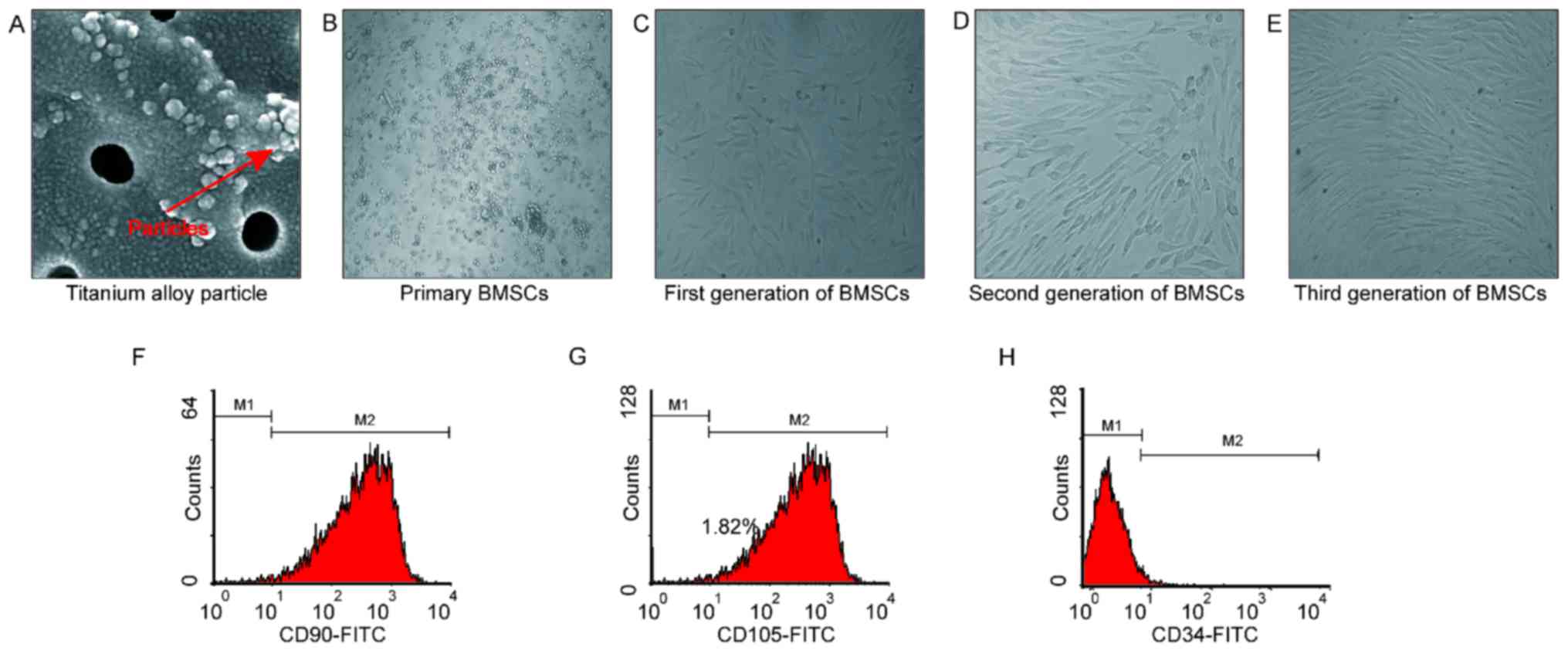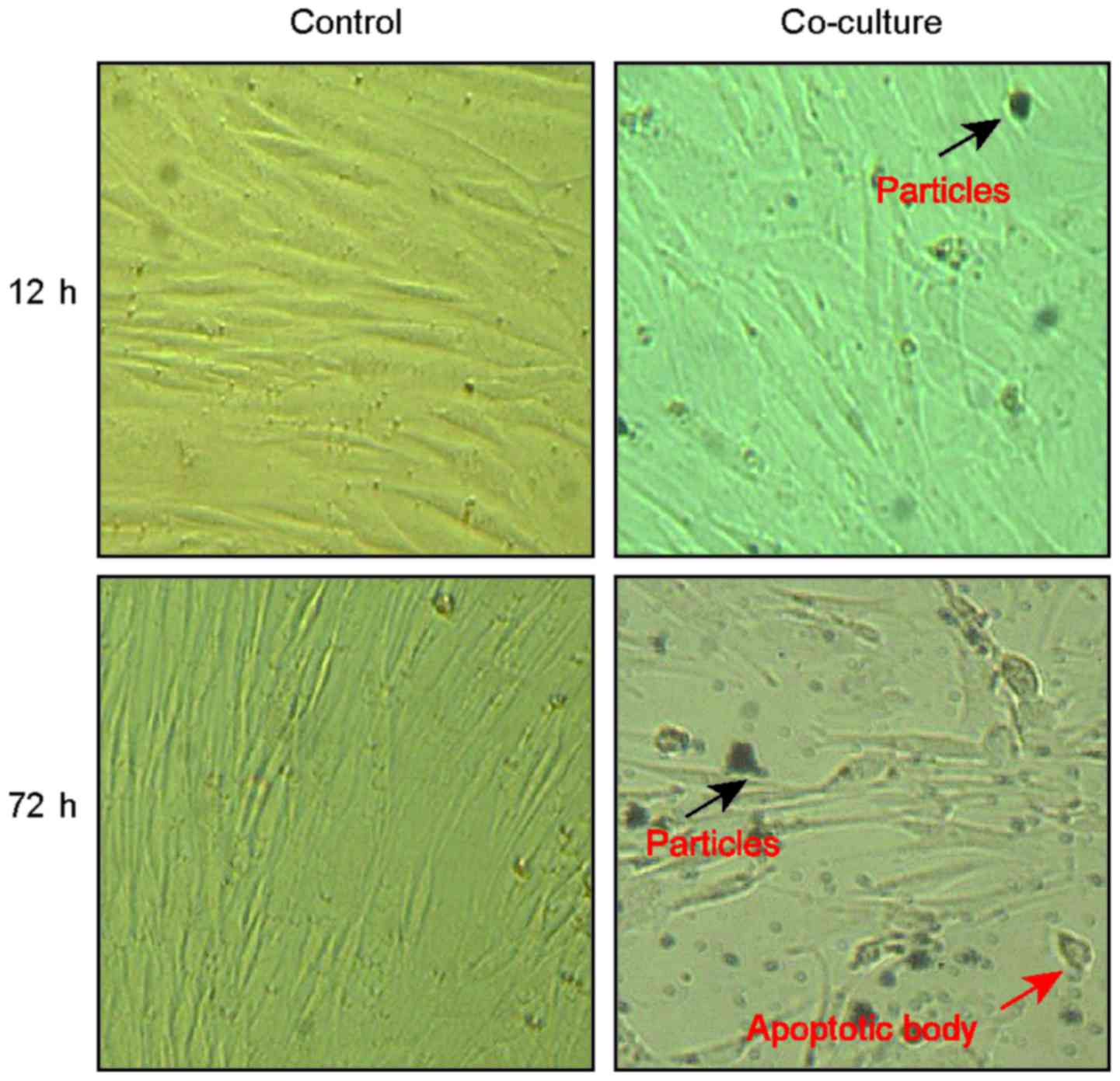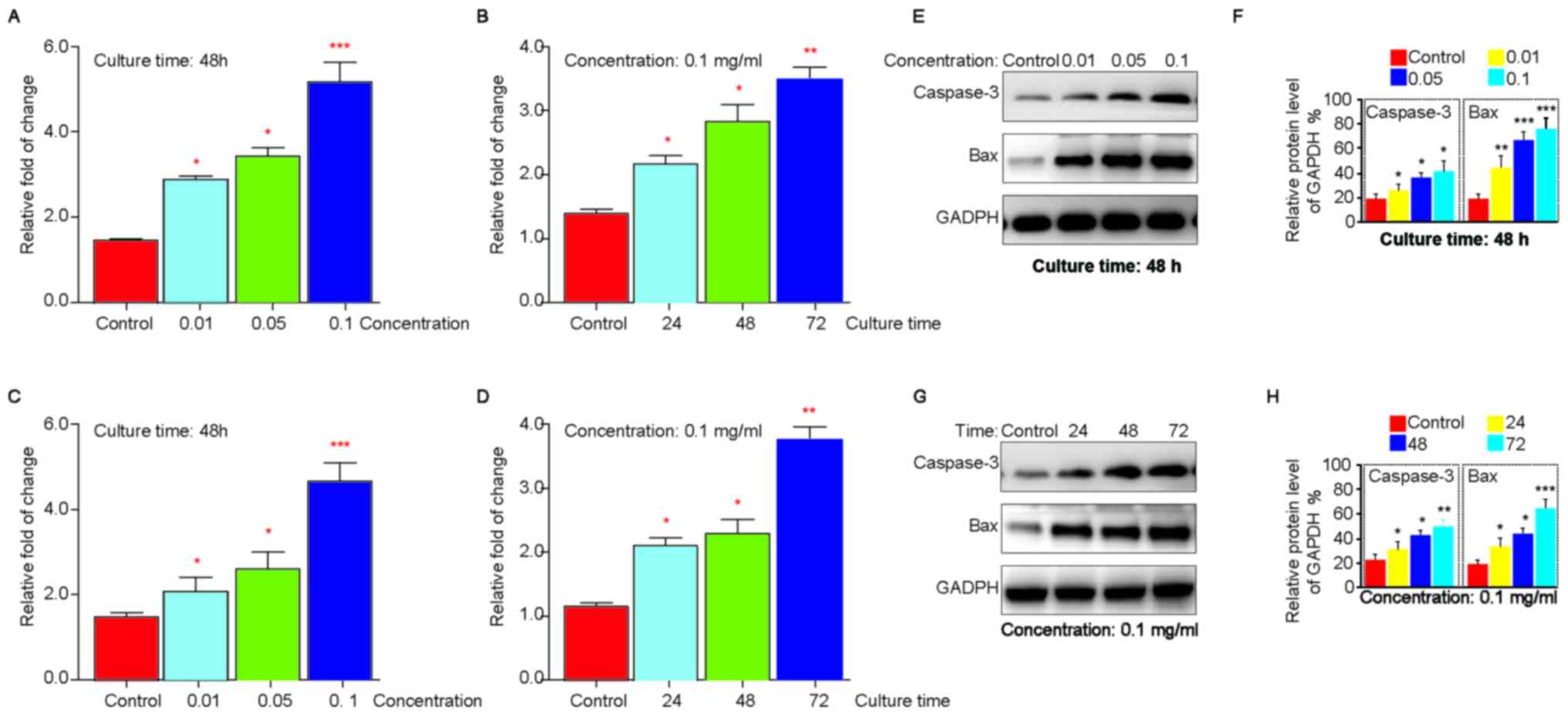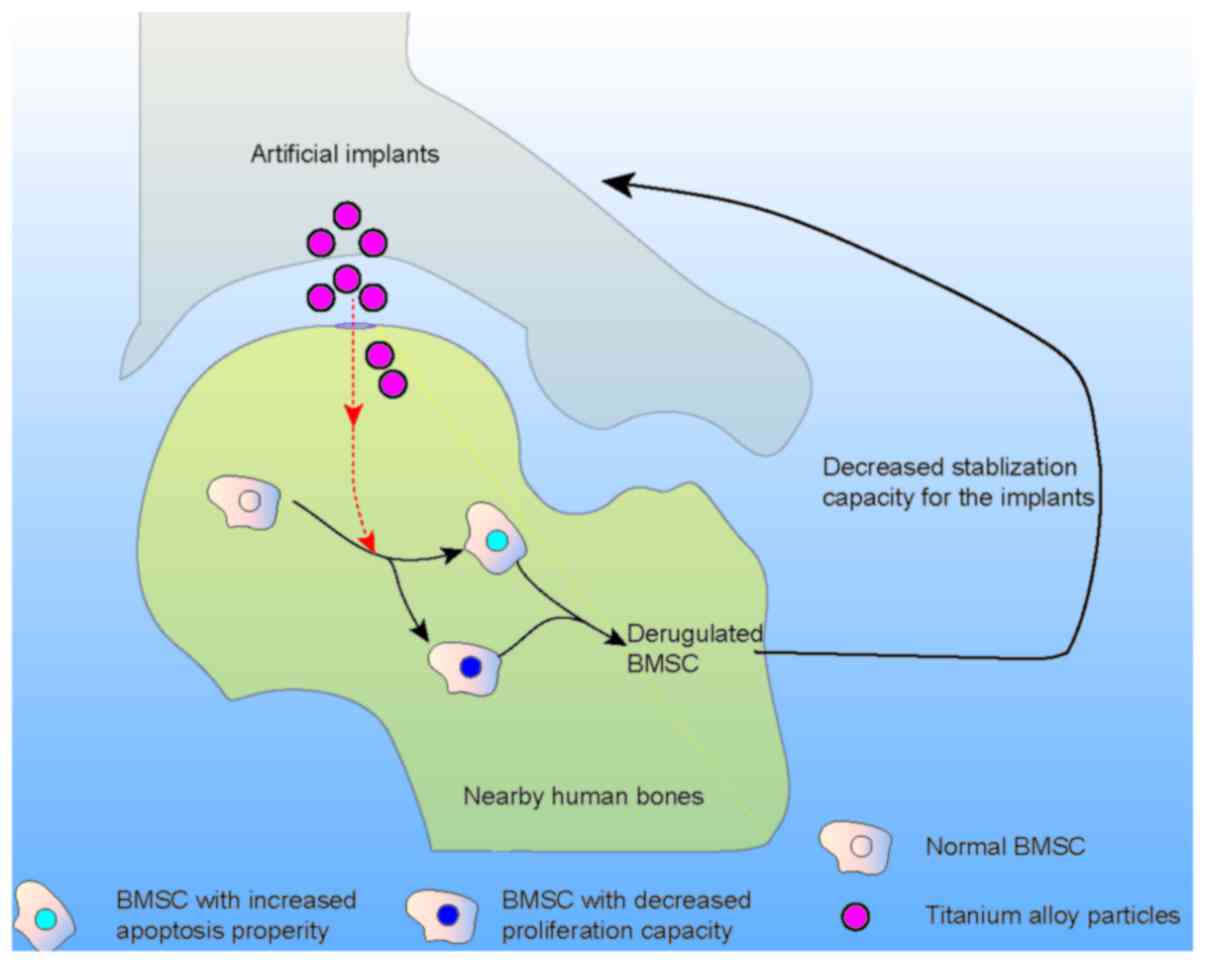Nano-sized titanium alloy particles inhibit the proliferation and promote the apoptosis of bone marrow mesenchymal stem cells in vitro
- Authors:
- Published online on: November 20, 2017 https://doi.org/10.3892/mmr.2017.8105
- Pages: 2271-2276
-
Copyright: © He et al. This is an open access article distributed under the terms of Creative Commons Attribution License.
Abstract
Introduction
Since total joint arthroplasty was applied in the clinics, it had improved the life qualities for patients who suffered osteoarthritis and rheumatoid arthritis all through the world (1). However, with the time passed by, patients who had received total joint arthroplasty were increasing, and its complications were now drawing more and more attentions (2). Aseptic loosening of the implanted artificial joint was stated to be the most common complication of total joint arthroplasty, and it was also reported to be the leading cause of failures for those received total joint arthroplasty (3). Recently, great advancements had been made toward the pathogenesis of aseptic loosening; but few had been transformed to serve the patients in the clinics (4). Hence, it is of great urgency to identify the cellular and molecular mechanisms whereby aseptic loosening occurs so as to reveal novel targets against the complication.
In the clinical settings, titanium and its alloys were the preferred material for medical implants dues to the properties of high strength and ductility, good corrosion resistance, biological compatibility and long fatigue life (5). As with other stainless steel and cobalt-chromium alloy implants, titanium-alloy implants also produce high levels of particles (6), which function extensively in aseptic loosening of the implants (4,7,8). These particles, on the one hand, shatter around the artificial joints, and been swallowed by the nearby cells, such as fibroblasts, osteoblasts, macrophages and foreign body giant cells leading to their over-activation and cytokines secretion. These factors then function alone and/or in combination to promote aseptic osteolysis as well as aseptic loosening, and finally the failure of total joint arthroplasty replacement (9–11). On the other hand, these particles also interact with cells in the bone marrow once they permeated through the interfacial pathway between the prosthesis and marrow cavity (12,13), which was also said to affect aseptic loosening of the artificial joints.
Bone marrow mesenchymal stem cell (BMSC) is one of the most common adult stem cells within the bone marrow and they were characterized by the capacities of self-renewal and differentiation (14). Previously, line of reports indicated that BMSC function to facilitate the stabilization of the implanted artificial joints. For instance, Neale SD and colleagues demonstrated that BMSC could enhance the osseointegration of the peri-prosthetic bone after total hip arthroplasty (15). Besides, some other groups reported that BMSC are incline to differentiate into osteogenic cells (16), which were capable of stabilizing of the artificial joints. Taken together, we boldly concluded that deregulated BMSC was a risk factor for aseptic loosening of the artificial joint. However, there were still much to know whether titanium and its alloys derived particles facilitate aseptic loosening of the artificial joint via affecting the proliferation and apoptosis of BMSC.
In the present study, the pathomechanisms whereby the titanium-alloys particles contribute to aseptic loosing of artificial joints were investigated. We found that titanium-alloy implants derived particles significantly inhibit BMSC proliferation, and that the particles significantly increased the apoptosis of BMSC. Since BMSC plays a critical role in the stabilization of artificial joints, our study might provide a novel direction for the management of aseptic loosening in the clinics.
Materials and methods
Particle preparation
Briefly, 20 mg Ti-alloy particles (Polysciences, Inc., Warrington, PA, USA) were weighed by electronic microbalance and soaked by 70% alcohol for 48 h at room temperature. The particles were rinsed by phosphate buffer saline (PBS; Invitrogen; Thermo Fisher Scientific, Inc., Waltham, MA, USA) for 3 times and sterilized with epoxyethane gas. Then, they were autoclaved and suspended in Dulbecco's PBS (D-PBS; Invitrogen; Thermo Fisher Scientific, Inc.) so as to make stock solution. The final concentration 0.01, 0.05 and 0.1 mg/ml of the particles could be obtained when the stock solution was diluted with 20, 4 and 2 times respectively. All the steps were carried out in thoroughly clean, heat-sterilized glassware. The characterization of the particles was conducted under the microscope after their preparation. The ethic committees of the First Affiliated Hospital Of Nanjing Medical University approved our study. We also obtained approval from the animal ethics committees of our hospital.
BMSCs collection and primary culture
Femur and tibia of Japanese rabbits weighed 2 kg were used for the isolation and induction of BMSCs. The femurs and tibias were isolated under sterile condition, a needle was inserted into the bone, and the primary cells were aspirated, followed by flushing the bone using a 1 ml syringe filled with culture medium. The cells were immersed in low glucose Dulbecco's modified Eagle's medium (DMEM; Hyclone; GE Healthcare Life Sciences, Logan, UT, USA) supplemented with 2 mmol/l-glutamine (Gibco; Thermo Fisher Scientific, Inc.) and 100-ug/ml-penicillin streptomycin (Tianjin Pharmaceutical Group Co., Ltd., Tianjin, China). The cell suspension was subjected to separation using Fercoll solution as described previously. The cotton-like cells at the interface were collected and rinsed in L-DMEM containing 10% fetal bovine serum (FBS; Gibco; Thermo Fisher Scientific, Inc.). Cells were resuspended in complete medium (90% L-DMEM, 10% FBS, 100 µ/ml penicillin and streptomycin) and transferred to plastic culture flask for incubation at 37°C in a humidified atmosphere of 95% air and 5% CO2. Cells from the third generations were used for experimental purposes and were detached using trypsin for the subsequent experiments.
Flow cytometry (FCM) assay
FCM assay was used to confirm the phenotype of the induced BMSC from the third generation. The protocol had been described previously (17). The antibodies used in the assay were listed: Anti-rabbit CD34/CD90/CD105 (1:100; BD Biosciences, Franklin Lakes, NJ, USA).
Cell Counting Kit-8 (CCK8) assay
BMSC proliferation was determined using a CCK8 (Dojindo, Kumamoto, Japan) as described (18). BMSC were seeded in 96-well plates, serum starved and treated with the particles. At the end of the incubation, CCK8 solution was added for 4 h and the absorbance at 450 nm was measured with a micro plate reader (Sunrise; Tecan Group Ltd., Männedorf, Switzerland).
FCM assays
BMSCs cells were cultured in 6 well plates (Costar, Cambridge, MA, USA) at a density of 5×105/per well. After that, they were exposed to isoquercitrin for 24 h followed by 200 mol/l H2O2 for 4 h. Next, the cells were stained with Hoechst 33342 solution at 37°C for 10 mins in dark, followed by staining with PI at 25°C for 15 mins in dark. The stained cells were observed under a fluorescence microscope (BD Biosciences). Cells were counted using the Image pro-plus (version 6.0.0; Media Cybernetics, Rockville, MD, USA).
RNA isolation and RT-PCR assay
Total RNA was isolated from the cultured cells using RNA extraction kit (Takara Bio, Inc., Otsu, Japan) according to the manufacturer's instructions. Reverse transcription and RT-qPCR kits (Takara Bio, Inc.) were used to evaluate expression of Bax and Caspase-3. GAPDH was used to normalize for variance. The PCR Primers pairs used for each genes were: GAPDH, forward, 5′-CCCCGCTACTCCTCCTCCTAAG-3′, reverse, 5′-TCCACGACCAGTTGTCCATTCC-3′; Bax, forward 5′-CCGGGCGAACAGGGTACGAC-3′, reverse 5′-CGCGTGAAAGGGCGTCAGGT-3′; Caspase-3, forward 5′-ACGAAACCTCCGTGGACGCAA-3′, reverse 5′-CTCTGTGCCTCGGCAAGCCT-3′. Relative mRNA expression of each gene was calculated with the comparative threshold cycle (Cq) (2−ΔΔCq) method.
Western blot analysis
In Brief, cells were washed three times with cold PBS and lysed on ice in RIPA buffer with the protease inhibitor PMSF (Beyotime Institute of Biotechnology, Haimen, China). Protein concentrations were determined by BCA assay (Beyotime Institute of Biotechnology). A total of 20 µg protein was separated by 10% SDS-PAGE and electro-blotted onto NC membranes using a semi-dry blotting apparatus. After blocking in 3% bovine serum albumin (BSA), the membranes were incubated with primary antibodies overnight at 4°C. The membranes were washed and incubated with secondary antibodies for 1 h at 25°C on a shaker. The protein bands were visualized using a commercially available enhanced chemiluminesence kit (Thermo Fisher Scientific, Inc.). GAPDH and β-Actin were used as control. The primary antibodies used in this study include Caspase-2, Bax, β-Actin and GAPDH (Cell Signaling Technology, Inc., Danvers, MA, USA). The quantitation of the blots using image J as described previously (19).
Statistical analysis
Data are presented as mean ± standard deviation. Values and percentages between groups were compared using ANOVAs followed by appropriate post hoc tests. All statistical analysis was performed with SPSS statistical software (version 21.0; SPSS, Inc., Chicago, IL, USA). All statistics were two-sided, and P<0.05 was considered to indicate a statistically significant difference.
Results
The preparation of titanium alloy particles and BMSC
To begin with, we prepared the Titanium alloy particles as instructed. As shown in Fig. 1, 90% of the particles were ball in shape with a diameter of less than 100 nm (Fig. 1A). Meanwhile, BMSC were also prepared accordingly. We found that the primary BMSC (Fig. 1B) adhered within 36 h. After grown for 12 days, they were subjected to passage. Generally, cells from the first generation adhered within 24 h, and they were ribbed in shape (Fig. 1C). Cells from the second and third generation were uniformly and orderly arranged (Fig. 1D and E). Cells from the third generation were subjected to FCM inspections so as to examine their phenotypes. We found that the CD90, CD105 and CD34 positive cell rate were 99.5, 99.9 and 2.0% (Fig. 1F-H), which suggested that these cells were suitable for the subsequent experiments.
Morphology change of BMSC when cultured with titanium-alloy particles
We then investigated the effects of Nano-sized titanium-alloy particles on BMSC. Initially, the morphology changes of BMSC were observed. As we see, the cells exhibited no obvious change within 6 h compared to the normal control (Fig. 2). However, with time passed by, the treated cells become smaller in shape with the cytoplasm and unclear concentrated at 72 h (Fig. 2). In addition, we also observed shattered apoptosis body within the cells when they were cultured with the particles for 72 h (Fig. 2).
Cell proliferation of BMSC when co-cultured with titanium-alloy particles
Then, we investigated the proliferation of BMSC when they were cultured with the particles. As shown in Fig. 3A, we observed that the proliferation of BMSC decreased significantly (P=0.035) when they were cultured with low concentration particles (0.01 mg/ml). Of note, with the concentration grows, BMSC proliferation decreased. Statistically, our data showed that the particles inhibit the proliferation of BMSC in a manner dependent on the concentration (Fig. 3A). Meanwhile, we also examined whether co-culture time affects the proliferation of BMSCs. We found that the particles inhibit BMSCs proliferation in a manner dependent on culture time (Fig. 3B).
The apoptosis of BMSCs when co-cultured with titanium-alloy particles
Furthermore, we examined whether the particles facilitate the apoptosis of BMSC using co-culture strategy. We found under the microscope that low-density particles (0.01 mg/ml) had a slight effect on BMSC apoptosis (1.97%). However, with the concentration grows, their effect on BMSC apoptosis become more and more evident, exhibiting a concentration-dependent manner (Fig. 4A). Consistently, we observed that these particles confer the apoptosis of BMSC in a time-dependent manner (Fig. 4A). Correspondingly, FCM inspection also showed that the particles facilitate BMSC apoptosis in a manner dependent on time and concentrations (Fig. 4B).
To further confirm the role of titanium-alloy particles on apoptosis of BMSC, we analyzed specific apoptosis markers of the particles treated-cells using RT-PCR. We found that both Bax and Caspase-3 elevated in a time and concentration manner (Fig. 5A-D). Consistently, we also revealed that Bax and Caspase-3 expression decreased in protein level in a manner dependent on time and concentration (Fig. 5E and F). Taken together, our data suggested that Nano-sized titanium-alloy particles could facilitate the apoptosis of BMSC.
Discussion
It is widely accepted that postoperative aseptic loosening of the artificial joints was one of the most common complications for patients who received the management (7). Recent advancements had indicated that crosstalk between artificial joints derived particles and BMSC involve extensively in the process (20,21), suggesting that deregulated BMSC was a risk factor for aseptic loosening of the artificial joints. In the present study, we proposed that titanium-alloy particles that permeated into the bone marrow significantly inhibit the proliferation and promote the apoptosis of BMSC, which were critical in the stabilization of implanted artificial joints (Fig. 6). Taken together, our data revealed a novel mechanism whereby titanium-alloy implants derived particles facilitate aseptic loosening of artificial joints, suggesting that blocking titanium-alloy particles permeating into the bone marrow might be a novel direction to avoid septic loosening of artificial joints.
In general, the stabilization of newly implanted artificial joints was a complex process with the involvement of osteoblasts, osteoclasts as well as some side cells (21,22). These cells function synergistically to promote the stabilization of the artificial joints via cytokines and chemokine secretion. It is reasonable that deregulated functions of these cells were risky for the stabilization of artificial joints. In the clinics, revealing the dysfunctions of BMSC after implants replacement was becoming a hotpot. For one thing, the artificial joints-derived particles had been well stated to involve in septic loosening. For instance, Yao et al found that titanium derived particles significantly suppress the osteogenic function of osteoblast-like cells (23), which then induce osteoblast apoptosis directly or/and indirectly (24). For another thing, mounting studies suggested that deregulated cells nearby the implants were effective in aseptic loosening. As showed by Yrjo T Konttinen and colleagues, macrophages together with their bioactive factors play a critical role in the corrosion of the implants (25). Our study added the wealth knowledge, which showed that titanium particles facilitate aseptic loosening of the artificial joints by promoting apoptosis and inhibiting proliferation of BMSC. Our data shared a lot in common with the previous studies. For instance, Hou and colleagues also showed that Ti-alloy particles were effective in decreasing the proliferation of BMSC (26). However, there were also huge differences between the two studies. At first, the study by Hou learned the effect of Ti-alloy particles on BMSC on three levels (14, 108 and 196 nm), while our study only focused on particles particle with the diameter of 100 nm. Secondly, they investigated the role of particles on the adhesion, migration and differentiation of BMSC, while we focused on the proliferation and apoptosis of BMSC. Thirdly, we showed that the particles facilitate the proliferation and apoptosis of BMSC by decreasing proliferation and elevating apoptosis related factors. Despite these differences, both studies all concluded that the particle was a risk factor for dysregulated BMSC in vitro.
To be honest, there were also limitations of our study. For one thing, we give no clarifications on how the particles influence BMSC proliferation and apoptosis. Systematical literature review suggested that BMSCs usually differentiate into osteoblasts, which function as effector cells in the stabilization of artificial joint (27). These data provided the basis for our study as they pointed the critical role of BMSC in the stabilization of artificial joints. Meanwhile, other reports indicated that silicon ions decreased the proliferation of BMSC with the involvement of WNT and SHH signaling pathways (28). These studies indicated that PI3K/Akt, ERK1/2 and WNT signaling might also involve in particles resultant abnormal proliferation and apoptosis of BMSC. For another thing, our data was based on in vitro studies, and cells used in the study were from rabbits. We could not tell whether the particles affect human BMSC proliferation and apoptosis in the same manner. Meanwhile, the exact particle concentration within individuals for who received implants is not known, and these results will need to be validated in vivo as our study also did not tell whether the particles function similarly to the implant-derived particles.
In conclusion, we showed in our study that Nano-sized titanium particles suppress the proliferation of BMSCs in a manner dependent on time and concentration, and that the particles could promote BMSC apoptosis in the same manner. Since BMSCs plays a positive role in the stabilization of artificial joints, further studies are urgently needed in the near further to reveal the detailed crosstalk between the particles and BMSC so as to provide novel targets for aseptic loosening in the clinics.
References
|
Belatti DA, Pugely AJ, Phisitkul P, Amendola A and Callaghan JJ: Total joint arthroplasty: Trends in medicare reimbursement and implant prices. J Arthroplasty. 29:1539–1544. 2014. View Article : Google Scholar : PubMed/NCBI | |
|
Nwachukwu BU, Dy CJ, Burket JC, Padgett DE and Lyman S: Risk for complication after total joint arthroplasty at a center of excellence: The impact of patient travel distance. J Arthroplasty. 30:1058–1061. 2015. View Article : Google Scholar : PubMed/NCBI | |
|
Ribera A, Morata L, Moranas J, Agulló JL, Martínez JC, López Y, García D, Cabo J, García-Ramiro S, Soriano A and Murillo O: Clinical and microbiological findings in prosthetic joint replacement due to aseptic loosening. J Infect. 69:235–243. 2014. View Article : Google Scholar : PubMed/NCBI | |
|
Drees P, Eckardt A, Gay RE, Gay S and Huber LC: Mechanisms of disease: Molecular insights into aseptic loosening of orthopedic implants. Nat Clin Pract Rheumatol. 3:165–171. 2007. View Article : Google Scholar : PubMed/NCBI | |
|
Long M and Rack HJ: Titanium alloys in total joint replacement-a materials science perspective. Biomaterials. 19:1621–1639. 1998. View Article : Google Scholar : PubMed/NCBI | |
|
Salvati EA, Betts F and Doty SB: Particulate metallic debris in cemented total hip arthroplasty. Clin Orthop Relat Res. 293:160–173. 1993. | |
|
Jiang Y, Jia T, Wooley PH and Yang SY: Current research in the pathogenesis of aseptic implant loosening associated with particulate wear debris. Acta Orthop Belg. 79:1–9. 2013.PubMed/NCBI | |
|
Abu-Amer Y, Darwech I and Clohisy JC: Aseptic loosening of total joint replacements: Mechanisms underlying osteolysis and potential therapies. Arthritis Res Ther. 9 Suppl 1:S62007. View Article : Google Scholar : PubMed/NCBI | |
|
Hallab NJ and Jacobs JJ: Biologic effects of implant debris. Bull NYU Hosp Jt Dis. 67:182–188. 2009.PubMed/NCBI | |
|
Cooper RA, McAllister CM, Borden LS and Bauer TW: Polyethylene debris-induced osteolysis and loosening in uncemented total hip arthroplasty: A cause of late failure. J Arthroplasty. 7:285–290. 1992. View Article : Google Scholar : PubMed/NCBI | |
|
Schmalzried TP, Jasty M and Harris WH: Periprosthetic bone loss in total hip arthroplasty. Polyethylene wear debris and the concept of the effective joint space. J Bone Joint Surg Am. 74:849–863. 1992. View Article : Google Scholar : PubMed/NCBI | |
|
Granchi D, Amato I, Battistelli L, Ciapetti G, Pagani S, Avnet S, Baldini N and Giunti A: Molecular basis of osteoclastogenesis induced by osteoblasts exposed to wear particles. Biomaterials. 26:2371–2379. 2005. View Article : Google Scholar : PubMed/NCBI | |
|
Jacobs JJ, Roebuck KA, Archibeck M, Hallab NJ and Glant TT: Osteolysis: Basic science. Clin Orthop Relat Res. 1–77. 2001. | |
|
Bruder SP, Fink DJ and Caplan AI: Mesenchymal stem cells in bone development, bone repair, and skeletal regeneration therapy. J Cell Biochem. 56:283–294. 1994. View Article : Google Scholar : PubMed/NCBI | |
|
Wang ML, Sharkey PF and Tuan RS: Particle bioreactivity and wear-mediated osteolysis. J Arthroplasty. 19:1028–1038. 2004. View Article : Google Scholar : PubMed/NCBI | |
|
Zhao R, Li Y, Lin Z, Wan J, Xu C, Zeng Y and Zhu Y: miR-199b-5p modulates BMSC osteogenesis via suppressing GSK-3β/β-catenin signaling pathway. Biochem Biophys Res Commun. 477:749–754. 2016. View Article : Google Scholar : PubMed/NCBI | |
|
Bae IH, Park MJ, Yoon SH, Kang SW, Lee SS, Choi KM and Um HD: Bcl-w promotes gastric cancer cell invasion by inducing matrix metalloproteinase-2 expression via phosphoinositide 3-kinase, Akt, and Sp1. Cancer Res. 66:4991–4995. 2006. View Article : Google Scholar : PubMed/NCBI | |
|
Hu J, Wang X, Wei SM, Tang YH, Zhou Q and Huang CX: Activin A stimulates the proliferation and differentiation of cardiac fibroblasts via the ERK1/2 and p38-MAPK pathways. Eur J Pharmacol. 789:319–327. 2016. View Article : Google Scholar : PubMed/NCBI | |
|
Zhang JG, Li XY, Wang YZ, Zhang QD, Gu SY, Wu X, Zhu GH, Li Q and Liu GL: ROCK is involved in vasculogenic mimicry formation in hepatocellular carcinoma cell line. PLoS One. 9:e1076612014. View Article : Google Scholar : PubMed/NCBI | |
|
Jiang Y, Jia T, Gong W, Wooley PH and Yang S: Titanium particle-challenged osteoblasts promote osteoclastogenesis and osteolysis in a murine model of periprosthestic osteolysis. Acta Biomater. 9:7564–7572. 2013. View Article : Google Scholar : PubMed/NCBI | |
|
Otto M, Kriegsmann J, Gehrke T and Bertz S: Wear particles: Key to aseptic prosthetic loosening? Pathologe. 27:447–460. 2006.(In German). View Article : Google Scholar : PubMed/NCBI | |
|
Miller MD, Peters CL and Allen B: Early aseptic loosening of a total knee arthroplasty due to Gore-Tex particle-induced osteolysis. J Arthroplasty. 21:765–770. 2006. View Article : Google Scholar : PubMed/NCBI | |
|
Yao J, Cs-Szabó G, Jacobs JJ, Kuettner KE and Glant TT: Suppression of osteoblast function by titanium particles. J Bone Joint Surg Am. 79:107–112. 1997. View Article : Google Scholar : PubMed/NCBI | |
|
Pioletti DP, Leoni L, Genini D, Takei H, Du P and Corbeil J: Gene expression analysis of osteoblastic cells contacted by orthopedic implant particles. J Biomed Mater Res. 61:408–420. 2002. View Article : Google Scholar : PubMed/NCBI | |
|
Jämsen E, Kouri VP, Olkkonen J, Cör A, Goodman SB, Konttinen YT and Pajarinen J: Characterization of macrophage polarizing cytokines in the aseptic loosening of total hip replacements. J Orthop Res. 32:1241–1246. 2014. View Article : Google Scholar : PubMed/NCBI | |
|
Hou Y, Cai K, Li J, Chen X, Lai M, Hu Y, Luo Z, Ding X and Xu D: Effects of titanium nanoparticles on adhesion, migration, proliferation, and differentiation of mesenchymal stem cells. Int J Nanomedicine. 8:3619–3630. 2013.PubMed/NCBI | |
|
von Knoch F, Jaquiery C, Kowalsky M, Schaeren S, Alabre C, Martin I, Rubash HE and Shanbhag AS: Effects of bisphosphonates on proliferation and osteoblast differentiation of human bone marrow stromal cells. Biomaterials. 26:6941–6949. 2005. View Article : Google Scholar : PubMed/NCBI | |
|
Han P, Wu C and Xiao Y: The effect of silicate ions on proliferation, osteogenic differentiation and cell signalling pathways (Wnt and Shh) of bone marrow stromal cells. Biomater Sci. 1:379–392. 2013. View Article : Google Scholar |















